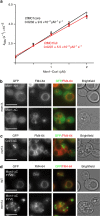Architecture and mechanism of the late endosomal Rab7-like Ypt7 guanine nucleotide exchange factor complex Mon1-Ccz1
- PMID: 28051187
- PMCID: PMC5216073
- DOI: 10.1038/ncomms14034
Architecture and mechanism of the late endosomal Rab7-like Ypt7 guanine nucleotide exchange factor complex Mon1-Ccz1
Abstract
The Mon1-Ccz1 complex (MC1) is the guanine nucleotide exchange factor (GEF) for the Rab GTPase Ypt7/Rab7 and is required for endosomal maturation and fusion at the vacuole/lysosome. Here we present the overall architecture of MC1 from Chaetomium thermophilum, and in combining biochemical studies and mutational analysis in yeast, we identify the domains required for catalytic activity, complex assembly and localization of MC1. The crystal structure of a catalytic MC1 core complex bound to Ypt7 provides mechanistic insight into its function. We pinpoint the determinants that allow for a discrimination of the Rab7-like Ypt7 over the Rab5-like Vps21, which are both located on the same membrane. MC1 shares structural similarities with the TRAPP complex, but employs a novel mechanism to promote nucleotide exchange that utilizes a conserved lysine residue of Ypt7, which is inserted upon MC1 binding into the nucleotide-binding pocket of Ypt7 and contributes to specificity.
Figures






Similar articles
-
The Mon1-Ccz1 complex is the GEF of the late endosomal Rab7 homolog Ypt7.Curr Biol. 2010 Sep 28;20(18):1654-9. doi: 10.1016/j.cub.2010.08.002. Curr Biol. 2010. PMID: 20797862
-
The Mon1-Ccz1 GEF activates the Rab7 GTPase Ypt7 via a longin-fold-Rab interface and association with PI3P-positive membranes.J Cell Sci. 2014 Mar 1;127(Pt 5):1043-51. doi: 10.1242/jcs.140921. Epub 2014 Jan 10. J Cell Sci. 2014. PMID: 24413168 Free PMC article.
-
Identification of a Rab GTPase-activating protein cascade that controls recycling of the Rab5 GTPase Vps21 from the vacuole.Mol Biol Cell. 2015 Jul 1;26(13):2535-49. doi: 10.1091/mbc.E15-02-0062. Epub 2015 May 13. Mol Biol Cell. 2015. PMID: 25971802 Free PMC article.
-
Membrane dynamics and fusion at late endosomes and vacuoles--Rab regulation, multisubunit tethering complexes and SNAREs.Eur J Cell Biol. 2011 Sep;90(9):779-85. doi: 10.1016/j.ejcb.2011.04.007. Epub 2011 Jun 16. Eur J Cell Biol. 2011. PMID: 21683469 Review.
-
Rab7: role of its protein interaction cascades in endo-lysosomal traffic.Cell Signal. 2011 Mar;23(3):516-21. doi: 10.1016/j.cellsig.2010.09.012. Epub 2010 Sep 21. Cell Signal. 2011. PMID: 20851765 Review.
Cited by
-
CCZ1 Accelerates the Progression of Cervical Squamous Cell Carcinoma by Promoting MMP2/MMP17 Expression.Biomedicines. 2024 Jul 3;12(7):1468. doi: 10.3390/biomedicines12071468. Biomedicines. 2024. PMID: 39062041 Free PMC article.
-
Thrombopoietin Secretion by Human Ovarian Cancer Cells.Int J Cell Biol. 2017;2017:1873834. doi: 10.1155/2017/1873834. Epub 2017 Mar 30. Int J Cell Biol. 2017. PMID: 28465688 Free PMC article.
-
A Steric Gating Mechanism Dictates the Substrate Specificity of a Rab-GEF.Dev Cell. 2019 Jan 7;48(1):100-114.e9. doi: 10.1016/j.devcel.2018.11.013. Epub 2018 Dec 6. Dev Cell. 2019. PMID: 30528786 Free PMC article.
-
Targeting of the Mon1-Ccz1 Rab guanine nucleotide exchange factor to distinct organelles by a synergistic protein and lipid code.J Biol Chem. 2023 Mar;299(3):102915. doi: 10.1016/j.jbc.2023.102915. Epub 2023 Jan 14. J Biol Chem. 2023. PMID: 36649906 Free PMC article.
-
Structure of the Mon1-Ccz1 complex reveals molecular basis of membrane binding for Rab7 activation.Proc Natl Acad Sci U S A. 2022 Feb 8;119(6):e2121494119. doi: 10.1073/pnas.2121494119. Proc Natl Acad Sci U S A. 2022. PMID: 35105815 Free PMC article.
References
-
- Jahn R. & Scheller R. H. SNAREs-engines for membrane fusion. Nat. Rev. Mol. Cell Biol. 7, 631–643 (2006). - PubMed
-
- Stenmark H. Rab GTPases as coordinators of vesicle traffic. Nat. Rev. Mol. Cell Biol. 10, 513–525 (2009). - PubMed
-
- Pan X., Eathiraj S., Munson M. & Lambright D. G. TBC-domain GAPs for Rab GTPases accelerate GTP hydrolysis by a dual-finger mechanism. Nature 442, 303–306 (2006). - PubMed
-
- Ishida M., Oguchi M. E. & Fukuda M. Multiple types of guanine nucleotide exchange factors (GEFs) for Rab small GTPases. Cell Struct. Funct. 41, 61–79 (2016). - PubMed
Publication types
MeSH terms
Substances
LinkOut - more resources
Full Text Sources
Other Literature Sources
Molecular Biology Databases

